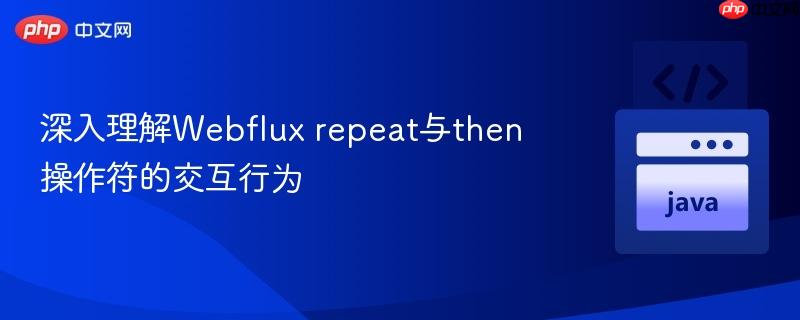
本文深入探讨了webflux中`repeat`和`then`操作符的复杂交互行为。`repeat`操作符会使其上游的publisher进行多次订阅,而`then`操作符则在接收到上游publisher完成信号后才执行。理解这两个操作符的相对位置及其对流类型(mono/flux)的影响,对于正确构建响应式数据流至关重要,尤其是在涉及重复执行和序列化操作的场景中。
repeat操作符用于使其上游的响应式流重新订阅指定次数。这意味着在repeat操作符之前的整个流会从头开始执行多次。
考虑以下示例:
import reactor.core.publisher.Mono;
public class RepeatExample {
public static void main(String[] args) {
Mono.just(5)
.doOnNext(i -> System.out.println("next 1: " + i))
.doOnNext(i -> System.out.println("next 2: " + i))
.doOnNext(i -> System.out.println("next 3: " + i))
.repeat(2) // 重复2次,总共执行3次
.subscribe();
}
}输出结果清晰地表明,doOnNext操作符打印了三次,每次都执行了所有三个语句:
next 1: 5 next 2: 5 next 3: 5 next 1: 5 next 2: 5 next 3: 5 next 1: 5 next 2: 5 next 3: 5
即使我们将repeat操作符的位置上移,只要它仍然在所有doOnNext操作符之前,其行为保持不变,因为它会触发整个上游流的重新订阅。
import reactor.core.publisher.Mono;
public class RepeatExample2 {
public static void main(String[] args) {
Mono.just(5)
.doOnNext(i -> System.out.println("next 1: " + i))
.repeat(2) // 重复2次,总共执行3次
.doOnNext(i -> System.out.println("next 2: " + i))
.doOnNext(i -> System.out.println("next 3: " + i))
.subscribe();
}
}输出与第一个示例相同:
next 1: 5 next 2: 5 next 3: 5 next 1: 5 next 2: 5 next 3: 5 next 1: 5 next 2: 5 next 3: 5
这表明repeat操作符会使其上游的整个Publisher重新订阅,而不影响其下游操作符的执行顺序。
then操作符用于在当前Publisher完成(即发出onComplete信号)后,订阅并执行另一个Publisher。它会忽略上游Publisher发出的所有元素,只关注其完成状态。
当repeat和then操作符同时出现在一个流中时,它们的相对位置将极大地影响流的执行逻辑。
如果then操作符位于repeat操作符之前,那么then操作符所引入的后续流也会被repeat操作符重复执行。
import reactor.core.publisher.Mono;
public class RepeatThenExample1 {
public static void main(String[] args) {
Mono.just(5)
.doOnNext(i -> System.out.println("next 1: " + i))
.doOnNext(i -> System.out.println("next 2: " + i))
.then(Mono.just("hello")) // Mono.just(5)完成后,执行Mono.just("hello")
.doOnNext(i -> System.out.println("next 3: " + i)) // 此时流的元素是"hello"
.repeat(2) // 重复整个上游流
.subscribe();
}
}输出结果:
next 1: 5 next 2: 5 next 3: hello next 1: 5 next 2: 5 next 3: hello next 1: 5 next 2: 5 next 3: hello
在这个例子中,Mono.just(5)完成,然后Mono.just("hello")被订阅并发出"hello"元素,接着doOnNext("next 3: " + i)打印"next 3: hello"。这个完整的序列(next 1: 5, next 2: 5, next 3: hello)被repeat(2)重复了两次,总共执行了三次。
这是最容易引起混淆的场景。当repeat操作符将一个Mono转换为一个会多次完成的Flux之后,如果then操作符位于repeat之后,那么then操作符将只会在整个repeat序列完全完成之后才执行一次。
import reactor.core.publisher.Mono;
import reactor.core.publisher.Flux; // 引入Flux以便于理解类型转换
public class RepeatThenExample2 {
public static void main(String[] args) {
Mono.just(5) // 类型:Mono<Integer>
.doOnNext(i -> System.out.println("next 1: " + i)) // 类型:Mono<Integer>
.repeat(2) // 类型:Flux<Integer> (重复2次,总共执行3次)
.doOnNext(i -> System.out.println("next 2: " + i)) // 类型:Flux<Integer>
.then(Mono.just("hello")) // 类型:Mono<String> (在前面的Flux完成所有重复后执行)
.doOnNext(i -> System.out.println("next 3: " + i)) // 类型:Mono<String>
.subscribe();
}
}输出结果:
next 1: 5 next 2: 5 next 1: 5 next 2: 5 next 1: 5 next 2: 5 next 3: hello
在这个例子中:
这解释了为什么next 3: hello只出现了一次,因为它是在整个重复序列结束后才被触发的。
以上就是深入理解Webflux repeat与then操作符的交互行为的详细内容,更多请关注php中文网其它相关文章!

每个人都需要一台速度更快、更稳定的 PC。随着时间的推移,垃圾文件、旧注册表数据和不必要的后台进程会占用资源并降低性能。幸运的是,许多工具可以让 Windows 保持平稳运行。

Copyright 2014-2025 https://www.php.cn/ All Rights Reserved | php.cn | 湘ICP备2023035733号